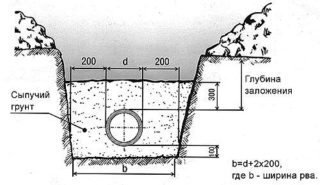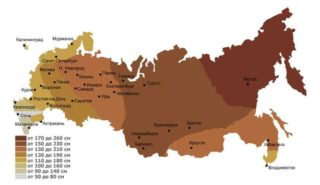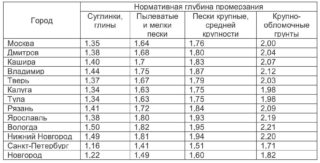The duration of its operation and uninterrupted operation depend on the correctly selected depth of immersion of the sewage system in the ground. The most severe test for the system is the cold season, as well as the spring and autumn seasons when groundwater rises, there is little snow, and unexpected frost can damage the system. If the depth of laying the pipes is insufficient, they can freeze, which will disable the sewage system. Another hazard is external mechanical stress. When the trench is less than 50 cm deep, when pipes are passed under a footpath or area where cars are driven, they can deform, leak, and the sewage system will fail.
On the other hand, with excessive deepening of the sewage system, the soil layer itself may exert excessive stress. This can lead to cracks in the system, especially when plastic pipes are used, which are less durable than cast iron pipes. To prevent this from happening, it is important not only to correctly calculate the optimal burial depth of pipes, but also to choose the right pipes themselves. Cast iron pipes are durable, but today they are used less and less. They were replaced by lighter and cheaper plastic ones. They are of two types: gray for indoor sewerage and orange for outdoor. Orange ones are made of durable material - unplasticized polyvinyl chloride. They have a thick wall - 3.2 - 3.4 mm, they have higher heat resistance and durability.
Depth standards and what affects them
The outlet of the domestic sewage system should be located 0.3 m above the freezing depth of the soil, because the wastewater is quite warm at the exit from the house. Then the cooling drains are protected from freezing by a layer of soil.
The deeper the sewage system is laid, the closer it is to groundwater. With a seasonal increase in their level, the sewage system may end up in the water. With a sharp drop in temperature, it can freeze and fail. To avoid this, it is necessary to insulate the sewer system.
To protect the sewer from freezing can:
- Heating cables.
- Insulation of pipes (foam or expanded polystyrene shell, basalt wool, foamed polyethylene).
Sewer pipes are laid at a slope so that the drainage of household waste occurs by gravity. Therefore, on a flat area, the depth of the trench must increase in order to create the desired slope. The slope depends on the diameter of the pipes:
- Ø = 5 cm - 3 cm per 1 m of length;
- Ø = 11 cm - 2 cm per 1 m length;
- Ø = 15 cm - 8 mm per 1 m of length;
- Ø = 20 cm - 7 mm per 1 m length.
If these parameters are not taken into account, then either the silting of the pipes is possible due to the slow movement of the flow, or blockages associated with the fact that the too rapid flow of water does not have time to wash away solid particles from the inner walls. Therefore, the maximum slope is strictly regulated - 15 cm per 1 m of pipe. SNiP recommend a fluid flow rate in the sewer pipes of 0.7 - 1.0 m / s. This speed is ensured by the angles of inclination recommended by regulatory documents for different pipe diameters.
Terrain relief and soil structure are important factors for the calculation.
The formula for determining the depth of soil freezing according to SNiP 2.02.01-83 is h = √M * k, where M * is the sum of the absolute average monthly temperatures (in winter) in a certain region, k is the coefficient for each type of soil:
- clay and loam - 0.23;
- sandy loam, fine and silty sands - 0.28;
- large, medium and gravelly sands - 0.3;
- coarse soil - 0.34.
With the advent of new technologies, cesspools are a thing of the past. Today, septic tanks are more often used, the depth of burial of which depends on their model. In any case, it is at least 1.5 m.
To calculate the depth of the trench at the point of connecting the pipeline to the wastewater tank, the formula is used: H2 = H1 + L × k, where:
- H2 - the depth of connection to the well;
- Н1 - the level of the sewerage outlet from the house;
- L is the length of the pipes;
- k - slope factor (0.03 for pipes Ø 5 cm, 0.02 for pipes Ø 10 - 11 cm, 0.01 - for a larger diameter).
If we take the length of pipes to the desired section for L, you can calculate the depth of the trench at any section of the drainage system.
Thus, in order to calculate the depth of laying a sewer pipe in a private house, you need the sum of the absolute average monthly temperatures in the region of interest and the nature of the soil on the site. Having calculated the depth of soil freezing, you need to subtract 30 cm from this figure. This will be the depth of the trench. In any case, it cannot be less than 70 cm.
Calculation example
For example, in Nizhny Novgorod, on an area with loamy soil, the depth of soil freezing is 1.447 m. Subtracting 0.3 m from this figure, we get 1.147 m.Thus, pipes with a diameter of less than 50 cm should be buried at a depth of 1.1 m.
If all the above conditions are met, you can be sure of the reliability and durability of the communications and enjoy all the benefits of civilization, enjoying life in nature, and not in the "stone jungle".











